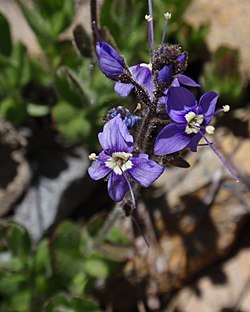| Veronica copelandii | |
|---|---|
 | |
| Scientific classification | |
| Kingdom: | Plantae |
| Clade: | Tracheophytes |
| Clade: | Angiosperms |
| Clade: | Eudicots |
| Clade: | Asterids |
| Order: | Lamiales |
| Family: | Plantaginaceae |
| Genus: | Veronica |
| Species: | V. copelandii |
| Binomial name | |
| Veronica copelandii | |
Veronica copelandii is a rare species of flowering plant in the plantain family known by the common name Copeland's speedwell.
It is endemic to California, where it is known only from the southeastern Klamath Mountains in Shasta and Trinity Counties. It occurs in mountain meadows and forest habitat in subalpine zones, usually on serpentine soils.
